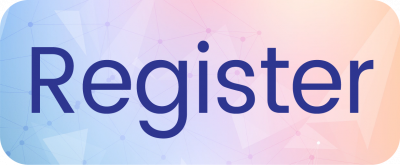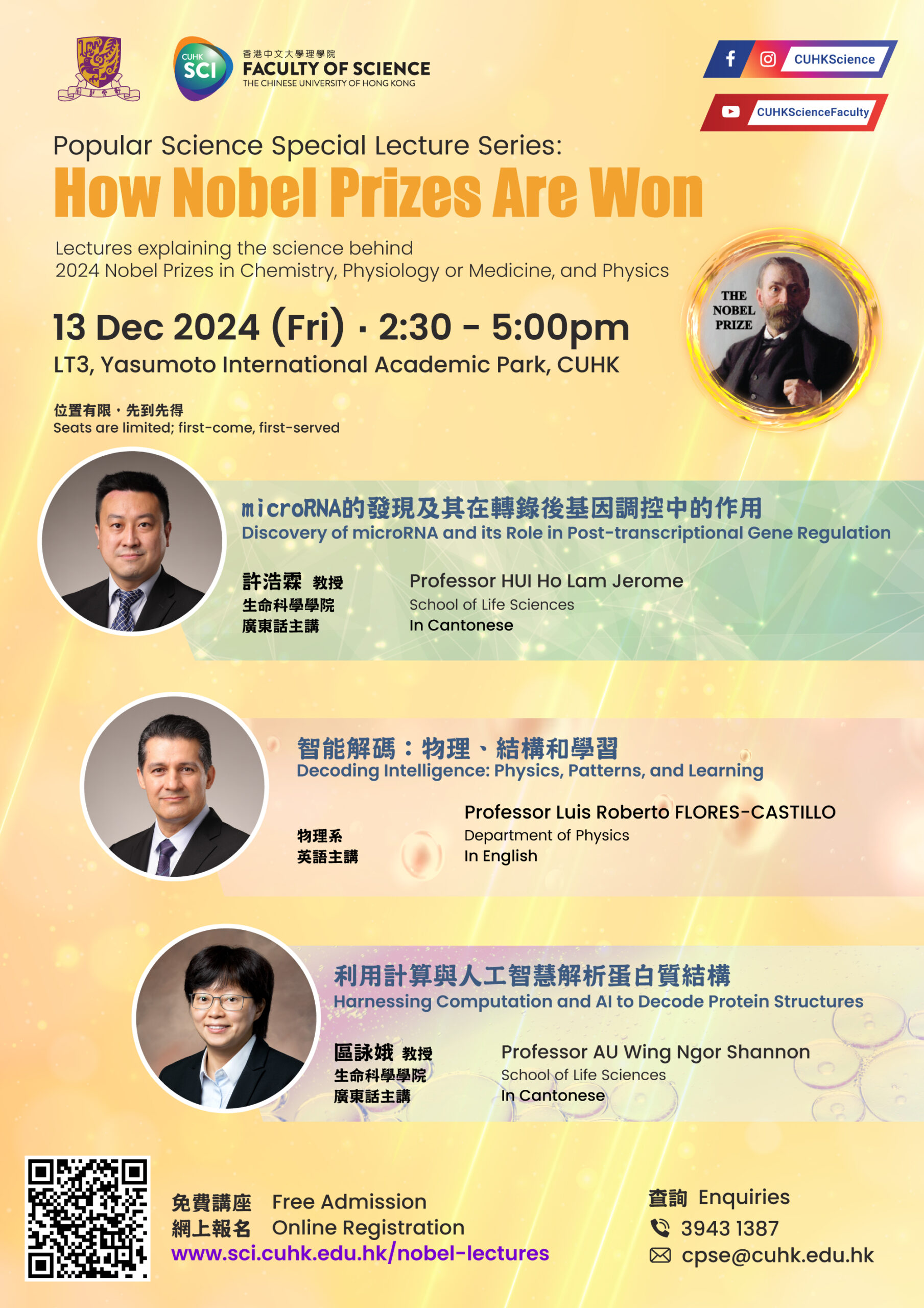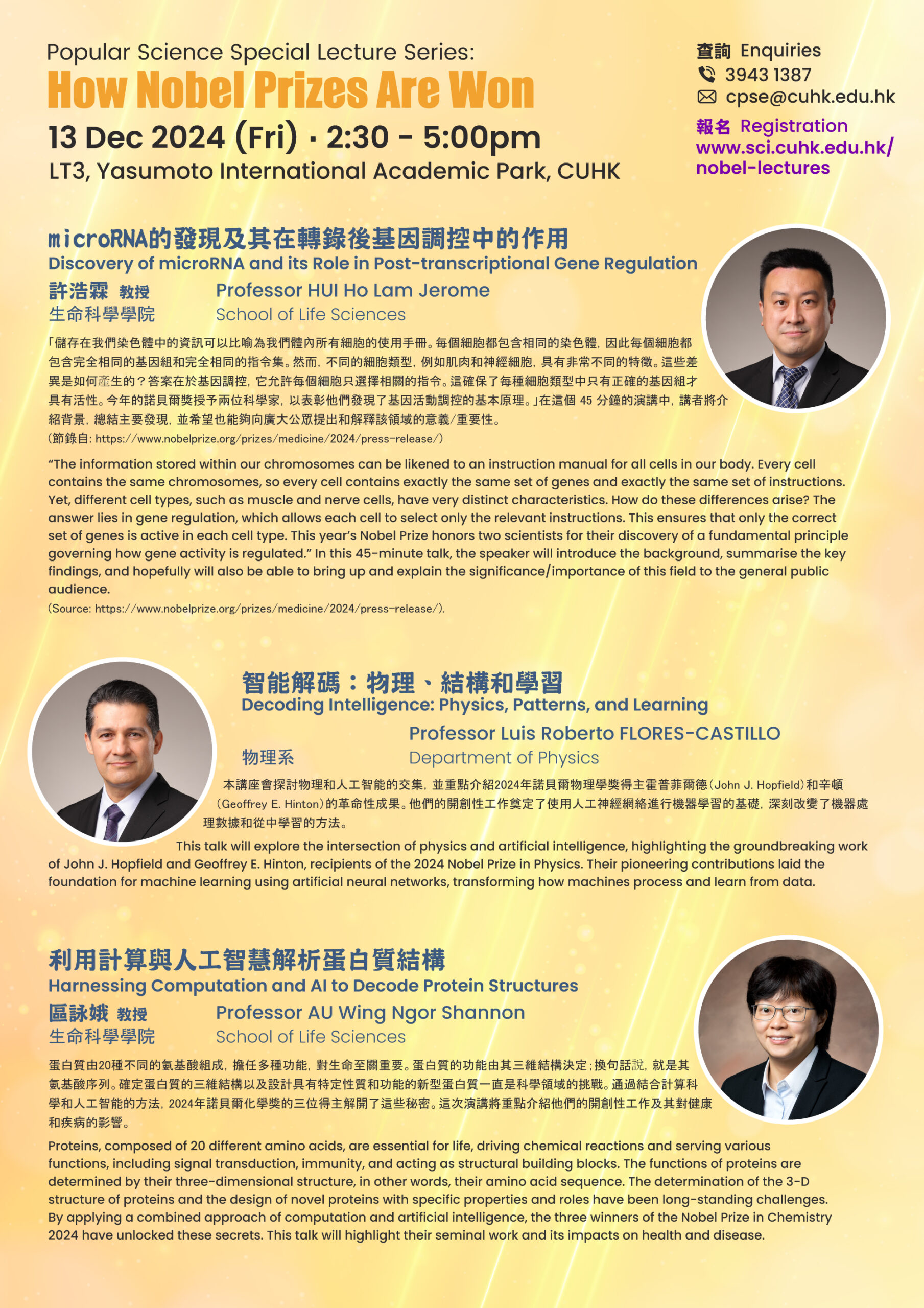- Home
- /
- Science For Youth
- /
- How Nobel Prizes Are Won
- /
- Latest Event
Latest Event
The Faculty of Science of The Chinese University of Hong Kong has been dedicated to promoting science to the general public, especially to young people. In addition to our annual Popular Science Talks, where our faculty members give talks on cutting-edge topics of science, we are pleased to hold a special Popular Science Lecture Series on research that covers topics related to each year’s Nobel Prizes in Physics, Chemistry and Physiology or Medicine.
This year, the Popular Science Special Lecture Series: How Nobel Prizes Are Won will be held on 13 December 2024 (Friday).
| Date | 13 December 2024 (Friday) |
| Time | 2:30 p.m. – 5:00 p.m. |
| Venue | LT3, Yasumoto International Academic Park, CUHK (Seats are limited; first-come, first-served) |
| Registration & Deadlines |  11 December 2024 (Wednesday) |
| Enquiries | 3943 1387 / cpse@cuhk.edu.hk |
Lecture Series Topics:
| Talk 1 |
Discovery of microRNA and its Role in Post-transcriptional Gene Regulation Professor HUI Ho Lam Jerome (School of Life Sciences) The information stored within our chromosomes can be likened to an instruction manual for all cells in our body. Every cell contains the same chromosomes, so every cell contains exactly the same set of genes and exactly the same set of instructions. Yet, different cell types, such as muscle and nerve cells, have very distinct characteristics. How do these differences arise? The answer lies in gene regulation, which allows each cell to select only the relevant instructions. This ensures that only the correct set of genes is active in each cell type. This year’s Nobel Prize honors two scientists for their discovery of a fundamental principle governing how gene activity is regulated.” In this 45-minute talk, the speaker will introduce the background, summarise the key findings, and hopefully will also be able to bring up and explain the significance/importance of this field to the general public audience. (Source: https://www.nobelprize.org/prizes/medicine/2024/press-release/). |
| Talk 2 | Decoding Intelligence: Physics, Patterns, and Learning (Science behind the Nobel Prize in Physics 2024) Professor Luis Roberto FLORES-CASTILLO (Department of Physics) This talk will explore the intersection of physics and artificial intelligence, highlighting the groundbreaking work of John J. Hopfield and Geoffrey E. Hinton, recipients of the 2024 Nobel Prize in Physics. Their pioneering contributions laid the foundation for machine learning using artificial neural networks, transforming how machines process and learn from data.
|
| Talk 3 | Harnessing Computation and AI to Decode Protein Structures (Science behind the Nobel Prize in Chemistry 2024) Professor AU Wing Ngor Shannon (School of Life Science) Proteins, composed of 20 different amino acids, are essential for life, driving chemical reactions and serving various functions, including signal transduction, immunity, and acting as structural building blocks. The functions of proteins are determined by their three-dimensional structure, in other words, their amino acid sequence. The determination of the 3-D structure of proteins and the design of novel proteins with specific properties and roles have been long-standing challenges. By applying a combined approach of computation and artificial intelligence, the three winners of the Nobel Prize in Chemistry 2024 have unlocked these secrets. This talk will highlight their seminal work and its impacts on health and disease. |



